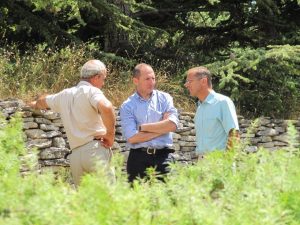
Bruno – Krzysztof – Alexis
Just like the priests and the consecrated laywomen, the laymen of Notre Dame de Vie, also called Sons of Notre Dame de Vie, want to unite contemplation and action in their professional, social and church life, according to the charism common to the three branches.
A witness – Hervé:
When I joined Notre Dame de Vie, I never imagined all the human and spiritual riches that I was going to discover there. Of course there was the encounter with Our Lord and the Virgin Mary. But there was also the discovery of so many brothers and sisters coming from all over the world, drawn by the same grace and enlivened by the same desire to do God’s will.
Obviously, living in community doesn’t go without some difficulty… but besides these small annoying things, which are only too normal and temporary, I have always felt, in my depths, the joy of belonging to a human and spiritual family.
With the Lord’s help, I try to live out my faith and my presence to others as best as I can. I must accept what sometimes appear to be limitations put on my freedom… but when this happens, the Lord makes me understand that this is for my own human and spiritual growth.
So I now give thanks, one more time, for this encounter with God on the hills of Taizé on August 9, 1985. I was not looking for Him but He came knocking at my door.
Welcome!
To spend a time for spiritual recharge or replenishment and/or to get to know us better, it’s possible to come and live with us for a few days in our community home in Venasque, especially during feast days or spiritually intense moments of the liturgical year (Holy Week, Ascension, Pentecost, All Saints’)….
Encounters can also be arranged in other places or through other means. Just contact us:
An original vocation in the Church
There are four main characteristic features of the vocation of consecrated laymen of Notre Dame de Vie. The Sons of Notre Dame de Vie are :
- fully consecrated to God by the profession of the evangelical counsels (chastity, poverty and obedience)
- fully laypeople in an ordinary life lived in the midst of the world, with a job and various activities linked to their context
- rooted in the spirit of Carmel and a life of prayer (two hours of silent prayer a day)
- participants in the Church’s mission in the world and from within the world.
A well adapted preparation
Fr Marie-Eugene, 4 November 1966
The first period of formation lasts two years and takes place in a centre of formation (at Venasque in France or at Encanto in the Philippines).
In consists mainly of gaining a practical competence in silent prayer, deepening knowledge of Scripture and Church teaching, and receiving the spirituality of the Carmelite saints as a staple diet. Through the simple reality of everyday life, members get used to living in the presence of God, listening to the Holy Spirit and putting themselves at his disposal. The timetable contributes to this training in a concrete way.
At the end of these two years, members commit themselves in a total gift of self to the institute of Notre Dame de Vie by vows of chastity, poverty and obedience.
The life is experienced for six years before definitive vows are ventured upon.
A life in the midst of the world
Most of the Sons of Notre Dame de Vie have a profession in either the public or the private sector : industry, civil engineering, medico-social, teaching, civil and diplomatic service, publishing, the craft industry …
They live alone or in small groups, without visible signs of their consecration.
When they share a house, their way of life is more like a family than a community, each man being responsible for finding his own rhythm so as to realize the demands of his vocation. For example, a senior manager will have a different rhythm from a schoolteacher.
The heart of this particular call to consecrated life (for God, for men) is revealed slowly through simple opportunities and through the witness of life.
(Fr Marie-Eugene of the Child Jesus)
Praying every day
Each member puts the Eucharist at the centre of his or her day and devotes two hours a day to silent prayer. Laypeople pray Morning Prayer (Lauds) and Compline, thus participating in the Church’s Liturgy of the Hours.
The group’s community life
Wherever they live, members try to stay in close contact with the person in charge of them and to develop relationships with the other members of the men’s branch.
To ensure that their life is balanced and their apostolate fruitful, they regularly come back to a house of replenishment which is like their family home.
A retreat of (at the very least) three consecutive weeks is made each year and this is often lived in common.
Today there are thirty members on 3 continents :
History
In 1947 a group of young people involved in important youth work in the diocese of Bordeaux and working mainly as teachers, met Fr Marie-Eugene. They were looking for a way of giving themselves completely to God while remaining laypeople.
From 1962 those who were to become the first members of the laymen’s branch took it in turns to spend several months at Notre Dame de Vie in Venasque, to do their ‘year of solitude’, the first stage in a commitment to consecrated life.
Formation for the young people who wanted to join them was organized in 1967. In 1973 the laymen’s branch was granted pontifical right, thus forming, with the other two branches – laywomen’s and priest’s – a single institute with three independent branches.







